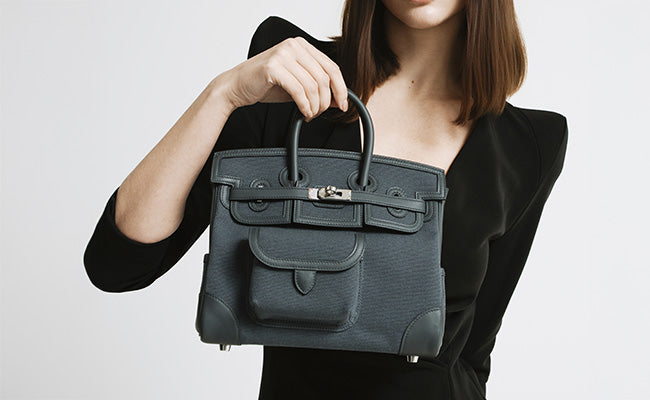
Corner Wear Hotspots: Why They Fray First and How to Protect
Check out our Hermès collection and Birkin bags!
That gorgeous Hermès corner you spotted in the boutique? Yeah, it’s also the first place wear shows up on your favorite bag.
Corners take the most impact when you set bags down, brush against things, or just use them day-to-day. The structured design of luxury bags doesn’t help either. Sharp, defined corners just get more abuse than rounded ones.
We’ve all been there, babying our investment bags, only to spot scuffs or material breakdown right where the bag’s geometry meets the real world.
Whether it’s a Birkin, Kelly, or any structured luxury piece, these vulnerable spots follow predictable patterns. Bottom corners get the worst of surface contact, while top corners deal with friction from opening and closing.
Different materials show wear in their own ways. Leather scuffs and loses its finish, canvas starts fraying.
The upside? You can actually prevent most corner wear with a few smart habits, and even if damage happens, you usually don’t need to shell out for a pricey restoration.
Key Takeaways
- Corners wear out first since they get the most impact and friction during daily use
- Materials like leather and canvas show corner damage differently, so you’ll want to protect them in specific ways
- Good storage, managing weight, and using protective accessories go a long way to keep your bag looking great
Why Bag Corners Are Prone to Wear
Bag corners really face a barrage of stress every day. Impact, design quirks, and material weaknesses all team up against them. Even Hermès can’t beat physics here.
Everyday Friction and Impact
Our handbags constantly touch surfaces all day long. Set your Birkin or Kelly down, and the corners are the first to hit tables, floors, car seats. Whatever’s there.
That repeated impact leaves tiny marks that add up. Sharp edges and pointed corners take the worst of it, while rounded shapes spread out the force and hold up better.
Friction’s another enemy. Bags brush against clothes, furniture, and random stuff as we move. That constant rubbing wears away protective finishes and slowly breaks down the leather.
Busy places like offices or restaurants? Not friendly to delicate leather corners. Hard surfaces, marble, concrete, are especially brutal.
Even small stuff adds up. Slide your bag across a desk or toss it in the trunk, and you’re creating friction that slowly wears down those corners.
Handbag Design and Structure
Structured bags with crisp corners are just more vulnerable than slouchy ones. The framework that gives a Kelly its shape also creates stress points.
Sharp, angular corners can’t flex to absorb impact. All the force goes right into those tiny spots instead of spreading out.
Corners are tricky construction-wise, too. Multiple pieces of leather meet up, creating seams and joints that just aren’t as strong as the rest of the bag.
Sometimes hardware makes it worse. Corner reinforcements, feet, or other elements can rub if they’re not aligned perfectly.
Weight distribution matters as well. Load up your bag, and gravity pulls down while the structure resists, so the corners get stressed.
Material Vulnerabilities
Different leathers handle corner stress in their own ways. Soft, vintage-style leathers stretch and deform at corners.
On the flip side, structured leathers with thick finishes can crack if flexed too much. That protective coating can get brittle as it ages.
Color really matters. Light leathers show scuffs and darkening much faster than darker ones. Black corners on a pale bag? Impossible to miss.
The tanning process changes things, too. Chrome-tanned and vegetable-tanned leathers age differently, each developing its own wear patterns.
Edge finishing is a big deal. Hand-painted edges on luxury bags last longer than raw or poorly sealed ones, which can fray and soak up moisture.
Identifying Corner Wear Hotspots
Corner wear usually shows up as edge breakdown and color changes. Clear signs the material’s struggling. It pays to check these spots for early warning signs.
Signs of Frayed Edges
Frayed edges are the biggest giveaway. You’ll spot tiny fibers separating, making the edges and corners look fuzzy or uneven.
Leather on Hermès bags frays when the finish wears off, exposing the fibers to friction and the elements.
What to look for:
- Loose threads poking out of seams
- Edges that feel rough or look uneven
- Little flakes of material coming off
- Texture changes you can feel with your fingertip
Canvas frays differently. Individual threads come loose from the weave, and they often look lighter than the rest.
Check high-contact spots first: corners, strap attachments, closure edges. These take the most abuse.
Assessing the Severity of Damage
How bad is it? That’ll decide if you need to fix it now or just keep an eye on things. Minor scuffs are one thing, but deep damage is another story.
Light damage:
- Surface scratches that don’t go through the finish
- Slight texture changes
- Barely noticeable color shifts
Moderate damage:
- Obvious color changes
- Small bits of missing material
- Edges feel much rougher
Severe damage:
- Deep gouges that show the base material
- Fraying that spreads past just the corners
- Corners feel weak or squishy
Press the area gently. Healthy leather bounces back, but damaged spots might feel soft or spongy.
If the bag’s structure is at risk or the damage seems to be spreading fast, it’s time to call in a pro.
Spotting Early Discolouration
Discoloration usually shows up before you see fraying. Catching it early can save you a headache later.
Natural light is best for checking color. Compare the worn spot to a protected area on the same bag.
Common warning signs:
- Slight darkening from oils
- Fading where the sun hits
- Grey or brown marks from metal hardware
- Patchy color that hints at the finish breaking down
Usually, you’ll see a subtle shade difference at first. Over time, these spots get more obvious as the coating wears away.
It helps to take photos in the same lighting every time. That way, you can track changes and make smarter decisions about maintenance.
Watch those hardware spots. Metal can react with leather and change its color before you even see wear.
Best Practices for Daily Protection
Protecting your Hermès bag’s corners comes down to daily habits. Simple storage, gentle cleaning, and smart storage locations can make a huge difference.
Using Dust Bags for Storage
Dust bags are a must for corner protection. These soft fabric covers keep your bag’s corners from rubbing against hard surfaces or other bags in your closet.
Always store your Hermès in its original dust bag if you still have it. The cotton lets air circulate but keeps dust and scratches away from delicate leather.
Never cram two bags in one dust bag. That just creates pressure points and dents. Each bag needs its own space.
Lost the original? Pick up a quality replacement in soft cotton or linen. Skip synthetic fabrics. They trap moisture and can mess up your leather over time.
Gentle Cleaning Habits
Corners need a gentle touch. Go for a soft cloth. Microfiber or cotton works best.
Dust weekly by gently wiping the corners with a dry cloth. This keeps dirt from building up and scratching the leather. No need for aggressive scrubbing. Just smooth, light motions.
For deeper cleaning, use a barely damp cloth with distilled water. Skip harsh chemicals or leather cleaners near corners, since they absorb products quickly and might discolor.
Pat, don’t rub if you spill something or spot a mark near a corner. Rubbing just grinds dirt in and speeds up wear.
Choosing Safe Storage Locations
Where you store your bag matters more than you’d think. Bedroom closets with steady temperatures are best for long-term storage.
Don’t keep bags near heaters, windows, or humid places like bathrooms. Temperature swings make leather expand and contract, which stresses the corners.
Shelf storage is better than hanging. Use padded dividers so bags don’t slide into each other.
Try to keep your storage area as dark as possible. UV rays break down leather fibers at corners first, since they stick out and get more light.
Maintenance Essentials for Luxurious Bag Corners
Keeping corners supple and crack-free means conditioning the leather and cleaning regularly. These basics keep your bag looking its best.
Conditioning and Moisturizing Leather
Condition bag corners every 3 to 4 months to keep them flexible. Dry leather cracks fast, especially where it bends most.
Pick a leather conditioner made for your specific leather type. Swift, Togo, Epsom. They all need different care. Always test on a hidden spot first.
Dab on just a little conditioner with a soft cloth, using circles. Pay extra attention to corners. Let it soak in for 15 to 20 minutes, then buff off the excess.
Don’t overdo it. Too much conditioner can darken leather or leave it sticky. If it feels tacky or you see residue, you’ve used too much.
Regular Cleaning Techniques
Clean corners weekly with a soft cloth to get rid of dirt and oils. Handling your bag daily leaves residue that slowly breaks down the leather.
Use a proper leather cleaner, not household soap. Soap and water strip oils and cause cracking. Put cleaner on the cloth, not straight on the leather.
Wipe gently in one direction. Don’t scrub back and forth. This keeps dirt from getting shoved deeper into the grain. Focus on bottom corners since they hit surfaces the most.
For tough marks, use a barely damp cloth with cleaner. Take your time, let each spot dry before moving on.
Repairing and Restoring Worn Corners
When corners start to show wear, you’ve got three main repair options: adhesive for loose edges, filler for deep damage, and edge paint for color touch-ups. Each one tackles a different kind of problem.
Leather Adhesive Fixes
Leather adhesive works when corners start lifting or edges get loose. It’s best for early-stage wear. Deep gouges need more.
Clean the area first, removing any loose bits. Apply the adhesive in a thin layer with a brush or cotton swab.
Tips:
- Work between 15 to 25°C for best results
- Use light pressure (clamps or weights) for a few hours
- Don’t use too much or it’ll seep out
Press the leather firmly back in place. Small clamps or a gentle weight help while the glue sets.
Adhesive usually cures in 24 hours. Test the bond before using your bag as usual. Good adhesives stay flexible, so corners don’t crack as the bag moves.
Leather Filler Solutions
Deeper scratches or gouges need leather filler. This paste rebuilds the surface where material’s missing.
Clean and dry the spot. Apply filler in thin layers. Don’t try to fill a deep gouge all at once.
How to do it:
- Press filler into scratches with a palette knife
- Smooth it while wet
- Let each layer cure for about 30 minutes
- Sand gently with 400-grit paper between coats
Usually 2 to 3 thin coats do the trick. Take your time. Rushing leads to obvious, lumpy repairs.
Edge Paint Touch-Ups
Edge paint is the final step, sealing repairs and matching color.
Pick a paint that matches your bag’s finish. Most luxury brands use unique colors, so generic black or brown rarely looks right.
Apply with a small brush in thin strokes, following the grain.
Technique:
- Use several thin coats, not one thick one
- Wait 15 to 20 minutes between coats
- Buff gently with a soft cloth after the last coat
Edge paint seals out moisture and dirt. Don’t skip this step. DIY repairs often fall apart without it.
Done right, edge paint should blend in and feel smooth, not sticky or rough. Color matching is everything here. Take your time.
Upgrading and Customising Protection
If you want real peace of mind for your Hermès, don’t just cross your fingers and handle it gently. Smart upgrades, like high-quality leather protectors and thoughtful material choices, offer real, lasting defense against corner wear.
Applying Leather Corner Protectors
You can add discreet leather corner protectors to vulnerable bag areas before any damage crops up. Thin adhesive strips, if matched well to your bag’s color and grain, blend in surprisingly well.
For high-value bags, it’s honestly best to let a pro handle application. We usually position protectors on bottom corners, handle attachments, and closure spots. Basically anywhere hardware rubs and causes friction. Since the adhesive bonds for good, a steady hand really helps.
Clear protective film is another option, especially for lighter leathers like Craie or Beton. Just cut the film a bit larger than the area you want to cover, and smooth out the bubbles as you go.
Some collectors slap on protectors right after they get the bag; others wait until they spot the first scuff, hoping to stop things from getting worse while hiding the blemish.
Selecting Durable Bags and Materials
We pick Hermès leathers based on how we’ll actually use the bag. Togo and Clemence are champs at resisting scratches compared to more delicate leathers like Chèvre or Swift.
Box leather? Gorgeous patina over time, but wow, it shows every little mark at first. Epsom leather is easy to clean and keeps its shape, so it’s practical for everyday use if you want your bag to last.
Hardware color isn’t just about looks. Palladium and ruthenium finishes tend to hide scratches better than gold-tone ones, which can draw attention to wear, especially on corners and clasps.
Bag construction makes a difference too. Structured bags with reinforced corners and solid stitching stand up to daily use much better than soft, unlined styles that rely only on the leather.
Frequently Asked Questions
Corner protection for luxury bags means knowing where friction happens, picking sturdy materials, and sticking to good care routines.
What's the scoop on protecting the corners of my swanky Hermes bag from getting all tattered?
Corners get beat up first because they take the brunt of daily use. Every time you set your bag down or carry it by your side, those spots get the most action.
Best tip? Pay attention to where you put your bag. Always set it down on something soft. A scarf or a mat is way better than concrete or a rough table.
Clear corner protectors made for luxury bags are worth considering. They’re see-through, so they won’t mess with your bag’s look.
Regular conditioning keeps the leather supple and less likely to crack. Dry leather splits fast, so don’t skip that step.
Could you spill the tea on the best materials for keeping those bag corners just as luxe as day one?
Full-grain leather stands up to corner stress better than corrected grain. Hermès uses fantastic leather, but even the best needs backup.
Togo and Clemence? They’re less likely to show corner damage than Swift or Chevre. Their texture hides scuffs you’d notice right away on smoother leathers.
Hardware matters, too. Bags with metal studs or reinforced corners last longer where it counts.
Got canvas or fabric bags? Totally different ballgame. Use a fabric protector spray made for luxury textiles to keep moisture and dirt at bay.
Hey, what's the secret behind ensuring our favourite arm candy stays pristine longer?
Rotate your bags. Using the same one every day just wears it out faster. Letting leather rest gives it time to recover.
Store your bags right, with dust bags and enough stuffing to keep their shape. If corners collapse, they crease and get weak.
Climate matters. Extreme heat or cold makes leather expand and contract, which leads to tiny tears, especially at corners.
And honestly, just be gentle when picking up or setting down your bag. That’s where most corner damage sneaks in.
Can you dish out any insider tips for those of us looking to pamper our bags at home?
Stick with Hermes-approved conditioners or pH-neutral ones. The wrong product can stain or damage leather, especially at the corners.
Use soft microfiber cloths for cleaning. Rough stuff just scratches and speeds up wear.
Always test new products on a hidden spot first. No one wants to gamble with their investment pieces.
Keep bags away from direct sunlight and heat. UV rays weaken leather, and corners are usually the first to go.
What's the buzz on professional touch-ups for bags, worth the splurge to keep the corners chic?
Professional restoration is usually cheaper than buying a new bag. Corner repairs often run $1,200-2,000, which is way less than a brand new Hermès.
Authorized Hermès spa services help maintain resale value better than random repair shops. They stick to original materials and techniques, so authenticity isn’t compromised.
Fixing small scuffs early saves money. If you let it go, full corner reconstruction gets pricey.
If you’re going to a specialist, pick one with real Hermès experience. Luxury leather is tricky, and not every repair shop knows how to handle it.
Let's chat about daily care routines, got any ritzy advice for the fabulously fashionable Hermes aficionado?
Take a peek at the corners every week. Spotting a scuff or a loose thread early can save you a headache (and a hefty bill) later.
After each outing, give your bag a quick once-over with a dry cloth. A little swipe keeps dirt from working its way in and messing up that gorgeous leather.
Once a month, treat high-use bags to a bit of leather conditioner. Don’t forget the corners. They always seem to take the biggest hit.
Snap a few photos of your bag now and then. It’s handy for tracking changes, and honestly, it makes insurance or resale a whole lot smoother.




